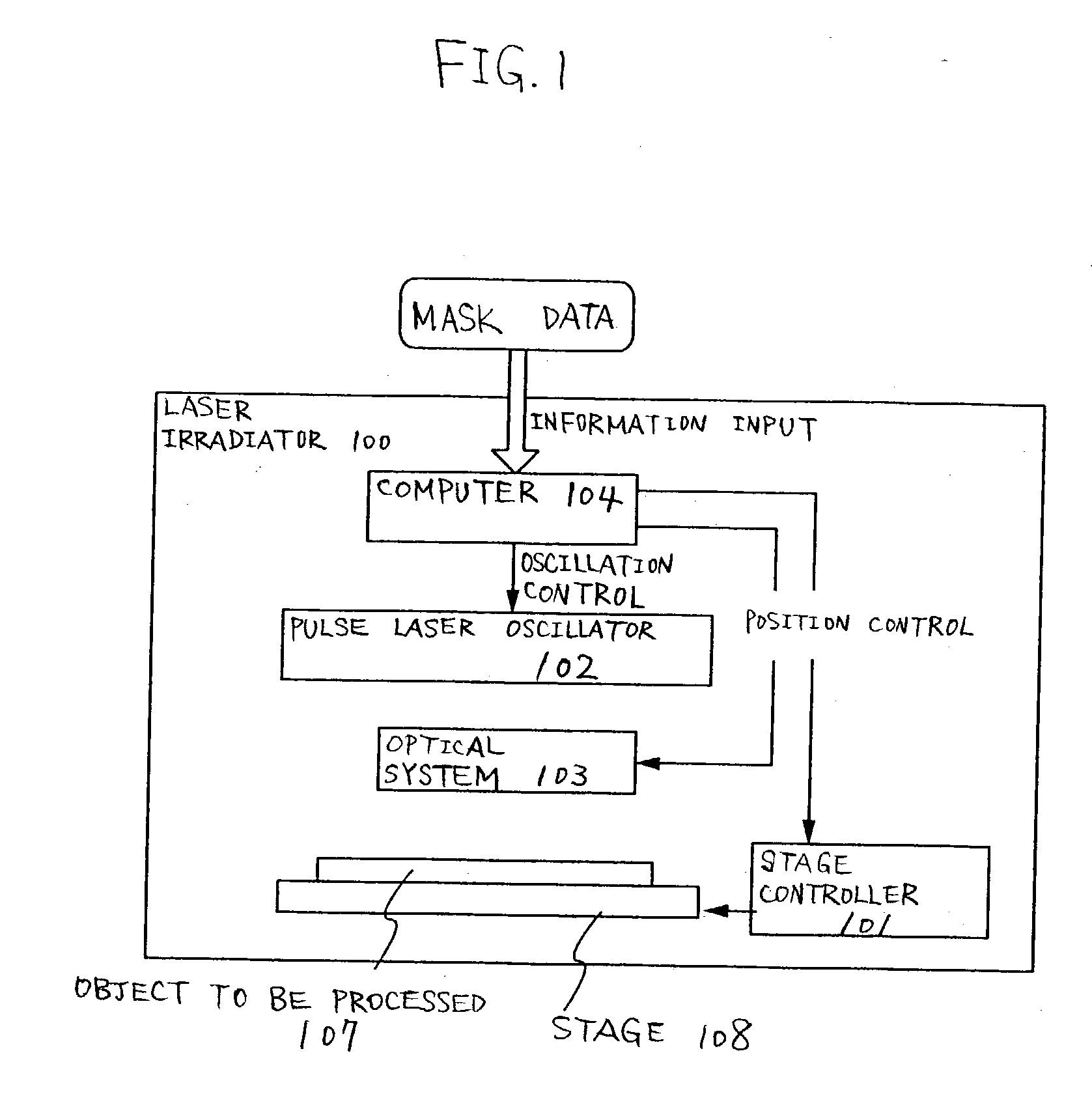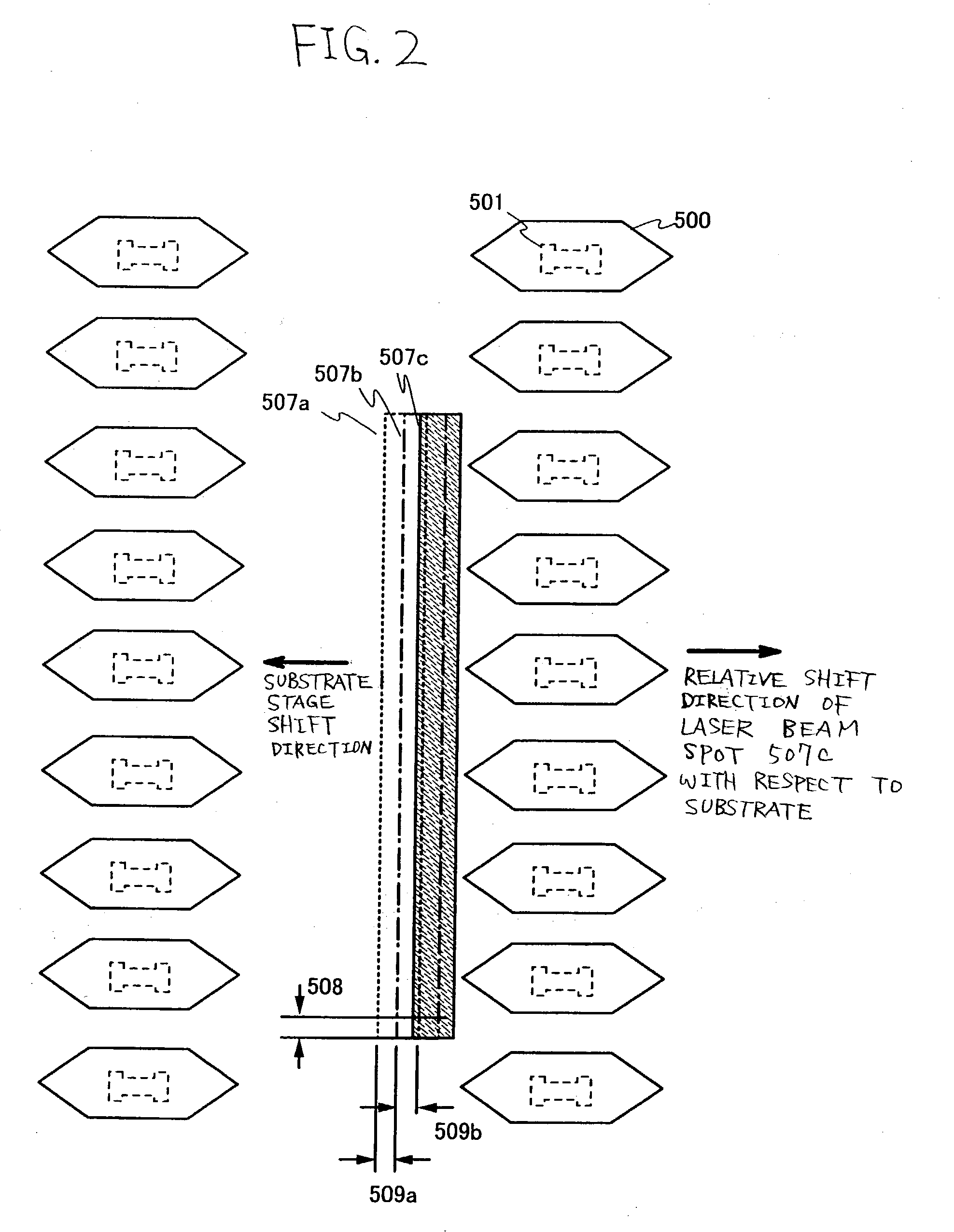Manufacturing method of semiconductor device
a manufacturing method and semiconductor technology, applied in semiconductor devices, semiconductor/solid-state device details, instruments, etc., can solve the problems of insufficient substrate processing efficiency (throughput), narrow energy intensity area, and inability to control the position where a large crystal grain is obtained, so as to increase the substrate processing efficiency
- Summary
- Abstract
- Description
- Claims
- Application Information
AI Technical Summary
Benefits of technology
Problems solved by technology
Method used
Image
Examples
example 1
[0083] Referring to FIGS. 6 to 9, in the Example 1, a manufacturing method of active matrix substrate will be described. Herein, as a matter of convenience, a substrate, which is formed with a CMOS circuit, a drive circuit, and a pixel section having a pixel TFT and a holding capacity on the same substrate, will be called as active matrix substrate.
[0084] First of all, in the Example 1, a substrate 600 comprised of a barium borosilicate glass or an aluminum borosilicate glass or the like is used. As for the substrate 600, a substrate formed with an insulating film on the surface of a quarts substrate, a silicon substrate, a metal substrate or a stainless substrate may be used. Also, a plastic substrate having heat resistance against the processing temperature of the Example 1 may be used.
[0085] Then, on the substrate 600, a base film 601 comprised of an insulating film of a silicon dioxide film, a silicon nitride film, or a silicon oxide nitride film or the like is formed in a manne...
example 2
[0126] In Example 2, a manufacturing method of a TFT using a laser irradiation method according to the invention will be described.
[0127] First of all, as shown in FIG. 12A, an amorphous semiconductor film is formed on an insulation surface, and then, the amorphous semiconductor film is subjected to an etching to form an island-like semiconductors 6001 and 6002. FIG. 12G is a top view of FIG. 12A, and a sectional view along the line A-A' is FIG. 12A. Then, as shown in FIG. 12B, an amorphous semiconductor film 6003 is formed to cover the island-like semiconductors 6001 and 6002. It is preferred that, immediately before forming the film, the film is subjected to rinse with diluted hydrofluoric acid to remove oxide film from the surface thereof, and then the amorphous semiconductor film 6003 is formed immediately. FIG. 12H is atop view of FIG. 12B, and a sectional view along the line A-A' is FIG. 12B.
[0128] Next, as shown in FIG. 12C, by subjecting the amorphous semiconductor film 6003...
example 3
[0131] Example 3 includes a process for crystallizing a semiconductor using a catalyst. Only the point, which is different from the Example 1, will be described. When a catalyst element is used, it is preferred to use the techniques, which are disclosed in Japanese Patent Laid-Open No. 7-130652 and in Japanese Patent Laid-Open No. 8-78329.
[0132] After forming the amorphous semiconductor film using Ni, the same is subjected to a solid-phase crystallization (hereinafter, the crystallization method will be referred to as NiSPC). For example, when the technique disclosed in Japanese Patent Laid-Open No. 7-130652, the amorphous semiconductor film is applied with solution of nickel acetate salt containing Nickel of 10 ppm in weight conversion to form a Nickel-containing layer, and after dehydrogenation processing for one hour at 500.degree. C., the same is subjected to a heat treatment for 4-12 hours at 500-650.degree. C.; for example, for 8 hours at 550.degree. C., to crystallize the sam...
PUM
| Property | Measurement | Unit |
|---|---|---|
| distance | aaaaa | aaaaa |
| distance | aaaaa | aaaaa |
| length | aaaaa | aaaaa |
Abstract
Description
Claims
Application Information
 Login to View More
Login to View More - R&D
- Intellectual Property
- Life Sciences
- Materials
- Tech Scout
- Unparalleled Data Quality
- Higher Quality Content
- 60% Fewer Hallucinations
Browse by: Latest US Patents, China's latest patents, Technical Efficacy Thesaurus, Application Domain, Technology Topic, Popular Technical Reports.
© 2025 PatSnap. All rights reserved.Legal|Privacy policy|Modern Slavery Act Transparency Statement|Sitemap|About US| Contact US: help@patsnap.com



